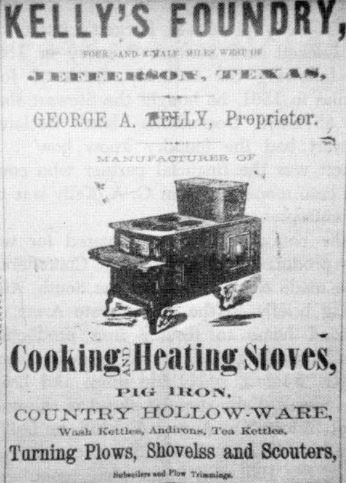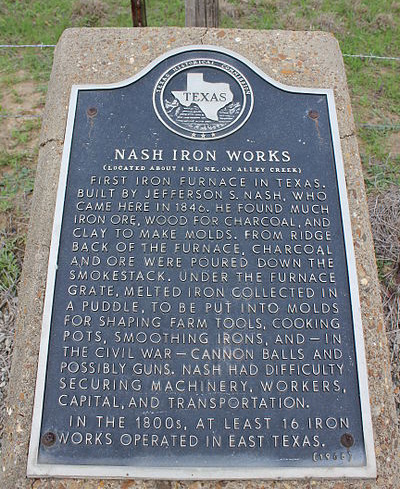|
Nash’s Iron Foundry, the first iron furnace
and foundry in Texas, was located sixteen miles northwest of Jefferson,
near the site of present Mims Chapel in northwestern Marion County (Cass
County until 1860). The furnace was built in 1847 on a tributary of
Alley’s Creek on the Walter H. Gilbert headright by Jefferson S. Nash, a
Cass County planter impressed with the quality of the local iron ore. A
foundry was added sometime thereafter, but it was only intermittently
operational.
|
 |
In 1857 the business, under the name J. S. Nash and Company,
was reorganized with three active partners: Nash, his son
William D. Nash, and David Browder, an expert in iron production
brought in from outside Texas. Plagued by chronic shortages of
money for equipment, the company approached the state
legislature for funding in the form of a land grant in 1857, but
no aid materialized.
In January 1858 the company was incorporated
as the Nash Iron, Steel, and Copper Manufacturing Company, and
by this time the Nash furnace is reported to have sent more than
10,000 pounds of iron to Jefferson, the nearest shipping point. |
Still hoping to receive financial assistance from the state legislature,
the company expanded and retooled its facilities in 1859 and 1860.
The secession crisis and the outbreak of the Civil War put an end to the
possibility of government aid, and the operation found its
transportation and equipment difficulties considerably aggravated by the
war.
|

|
In 1861 the company attempted to shift over to the manufacture of
cannons, cannon-shot, and rifles for the Confederate Army. A quantity of
cannon-balls was produced, but it appears that no artillery pieces or
small arms were manufactured. On March 5, 1863, the company was
reincorporated under the name Texas Iron Company.
The company continued to suffer from shortages of equipment and capital,
and the business was sold to the George A. Kelly Iron Company toward the
end of the war. Much of the plant was dismantled and moved to
Kellyville, and by the later 1860s all that remained of Nash’s
enterprise was an abandoned furnace. |
|
